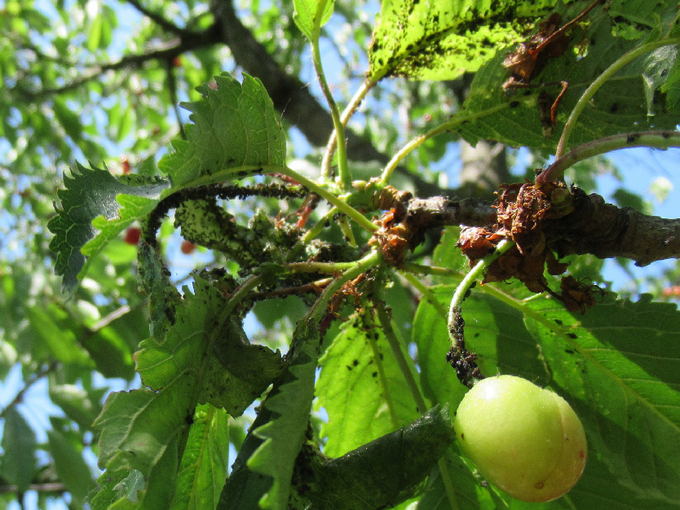Aphids
Aphidoidea
Profile
Aphids are represented in orchards by many different species that are either specialized to one host plant or have a broader host plant spectrum. Great importance lies above all in their role as vectors of plant viruses. Their sucking activity also causes direct damage to plants and, in addition, their sticky excretions enable the colonization of smut fungi.
Appearance


Aphids (Aphidoidea) are plant suckers and belong to the plant lice among the beaked aphids (Hemiptera). They are soft-skinned with a roundish-oval body shape in a wide variety of sizes and colors, with and without wax powder, depending on the species, and possess a sucking proboscis, variously formed abdominal tubes (siphons), and a little tail (cauda).
The tiny, unwinged larvae increase in size from molt to molt and look more and more like the adults (hemimetabolous insects) until either unwinged or winged individuals emerge.
There are a number of different species in individual orchard crops, the most important of which belong to the tubular aphid family (Aphididae).
The most important species in fruit crops:
Pome fruit:
- Green apple aphid(Aphis pomi).
- Apple aphid(Rhopalosiphum insertum)
- Mealy apple aphid(Dysaphis plantaginea)
- Apple aphid(Dysaphis devecta)
- Mealy pear aphid(Dysaphis pyri)
- Blood aphid(Eriosoma lanigerum)
Stone fruit:
- Green peach aphid(Myzus persicae)
- Black sour cherry aphid(Myzus cerasi)
- Black sweet cherry aphid(Myzus prunavium)
- Mealy plum aphid(Hyalopterus pruni).
Soft fruit:
- Nodule aphid(Chaetosiphon fragaefolii)
- Shallot aphid(Myzus ascalonicus)
- Small raspberryaphid (Aphis idaei)
- Large raspberry leaf aphid(Amphorophora idaei)
- Light green blackberry leaf aphid(Sitobion fragariae)
- Small gooseberry leaf shootaphid (Aphis grossulariae)
- Pale gooseberry aphid(Hyperomyzus pallidus)
- Small currantaphid (Aphis schneideri)
- Large currant aphid(Nasonovia ribis-nigri)
- Goose aphid(Hyperomyzus lactucae)
- Currant blister aphid(Cryptomyzus ribis)
- Elder leafaphid (Aphis sambuci)
Biology
Aphids usually live in colonies, consisting of unwinged and winged adults and their larvae, on shoots, especially on younger, juicy shoots (e.g., shoot tips), and often on leaf undersides, but also on buds and in flowers. There they suck plant sap by piercing the plant tissue (usually spongy parenchyma, rarely sieve tubes) with the help of their piercing-sucking mouthparts (proboscis).
There are species with host switching (switching from primary host to secondary host) as well as species that do not switch hosts and always remain on the same host plant. The succession of numerous generations per year from spring (approximately from April) to late summer and fall is very characteristic of aphids, often alternating between sexual and asexual reproduction by parthenogenesis (juvenile production), which can often lead to mass reproduction. Hibernation occurs either in the larval stage, as adults, or with winter eggs.
Damage symptoms
An appearance of aphids can be detected either by the animals themselves or by the damage they cause. The animals are almost always seen in more or less large colonies with winged and unwinged individuals on the undersides of leaves, succulent shoots and also on buds and in flowers.
Due to sap deprivation and the toxins secreted by the aphids in the process, the plant often reacts with leaf deformation and growth inhibition, such as:
- curled, rolled leaves
- wrinkles
- galling and other growths
- discoloration
- Shoot bulges
- formation of leaf nests
- Stunting of shoot tips
- death of infested parts
In addition, various sooty mold fungi settle on the sweet, sticky excrement (honeydew) on fruits and other plant parts, resulting in a blackish coating.
In winter, the shiny black winter eggs (0.5-0.6 mm) of the host-changing aphid species are usually found singly on shoots, buds, in branch holes and bark cracks and fissures, or in masses (as with the green apple aphid).


Economic importance
Great importance lies mainly in its role as a vector of plant viruses, such as the Sharka virus on plum by the green peach aphid. Their sucking activity directly causes damage to the plants and additionally enables the colonization of sooty mold fungi, which causes the leaves and fruits to be covered with blackish coatings.
Prevention and control
- Promotion and use of natural enemies: e.g. ladybugs, hoverfly larvae, lacewing larvae, ichneumon wasps, spiders, ground beetles, predatory bugs, birds.
- Application of "against animal pests overwintering on the tree" approved winter and budburst sprays (see list of plant protection products approved in Austria) against overwintering aphids and winter eggs of aphids during dormancy or during budburst. Ensure thorough wetting of all parts of the tree.
- Visual inspections of leaves, shoots, etc. at the time of pre-bloom, bloom and post-bloom to obtain information on the existing infestation pressure by aphids.Damage thresholds provide guide values to help decide on appropriate measures.
- Prune out and destroy aphid colonies when infestations are not too severe to prevent aphid damage from spreading. Glue rings on trunks and supports to prevent ants from migrating.
- During the growing season, apply pesticides registered for this purpose, especially the period immediately before and after flowering is important for aphid control. In the case of repeated treatments, it is necessary to pay attention to a change of active ingredient when selecting plant protection products in order to prevent the emergence of resistance (see thelist of plant protection products registered in Austria). However, care must also be taken to spare beneficial aphid predators and parasites.
Specialized information
Publications
Lethmayer, C., Rabitsch, W., 2002. plant lice (Sternorrhyncha). In: Essl, F., Rabitsch, W. (Ed.), Neobiota in Austria. Federal Environmental Agency, Vienna, 316-323.
Lethmayer, C., 2002. animal pests on elderberry: leaf miners, gall mites & co. Better Fruit, 10-11, 6-8.
Last updated: 16.09.2024
automatically translated